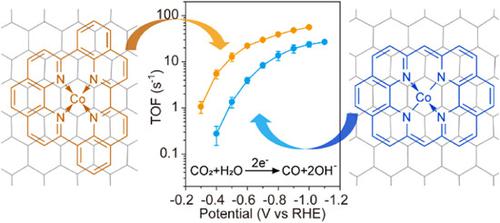当前位置:
X-MOL 学术
›
Carbon Energy
›
论文详情
Our official English website, www.x-mol.net, welcomes your feedback! (Note: you will need to create a separate account there.)
Metal–N4 model single-atom catalyst with electroneutral quadri-pyridine macrocyclic ligand for CO2 electroreduction
Carbon Energy ( IF 20.5 ) Pub Date : 2024-02-15 , DOI: 10.1002/cey2.506 Jian‐Zhao Peng 1 , Yin‐Long Li 1 , Yao‐Ti Cheng 1 , Fu‐Zhi Li 1 , Bo Cao 1 , Qing Wang 2 , Xian Yue 1 , Guo‐Tao Lai 1 , Yang‐Gang Wang 1 , Jun Gu 1
Carbon Energy ( IF 20.5 ) Pub Date : 2024-02-15 , DOI: 10.1002/cey2.506 Jian‐Zhao Peng 1 , Yin‐Long Li 1 , Yao‐Ti Cheng 1 , Fu‐Zhi Li 1 , Bo Cao 1 , Qing Wang 2 , Xian Yue 1 , Guo‐Tao Lai 1 , Yang‐Gang Wang 1 , Jun Gu 1
Affiliation

|
Metal–N–C single-atom catalysts, mostly prepared from pyrolysis of metal-organic precursors, are widely used in heterogeneous electrocatalysis. Since metal sites with diverse local structures coexist in this type of material and it is challenging to characterize the local structure, a reliable structure–property relationship is difficult to establish. Conjugated macrocyclic complexes adsorbed on carbon support are well-defined models to mimic the single-atom catalysts. Metal–N4 site with four electroneutral pyridine-type ligands embedded in a graphene layer is the most commonly proposed structure of the active site of single-atom catalysts, but its molecular counterpart has not been reported. In this work, we synthesized the conjugated macrocyclic complexes with a metal center (Co, Fe, or Ni) coordinated with four electroneutral pyridinic ligands as model catalysts for CO2 electroreduction. For comparison, the complexes with anionic quadri-pyridine macrocyclic ligand were also prepared. The Co complex with the electroneutral ligand expressed a turnover frequency of CO formation more than an order of magnitude higher than that of the Co complex with the anionic ligand. Constrained ab initio molecular dynamics simulations based on the well-defined structures of the model catalysts indicate that the Co complex with the electroneutral ligand possesses a stronger ability to mediate electron transfer from carbon to CO2.
更新日期:2024-02-17



























 京公网安备 11010802027423号
京公网安备 11010802027423号